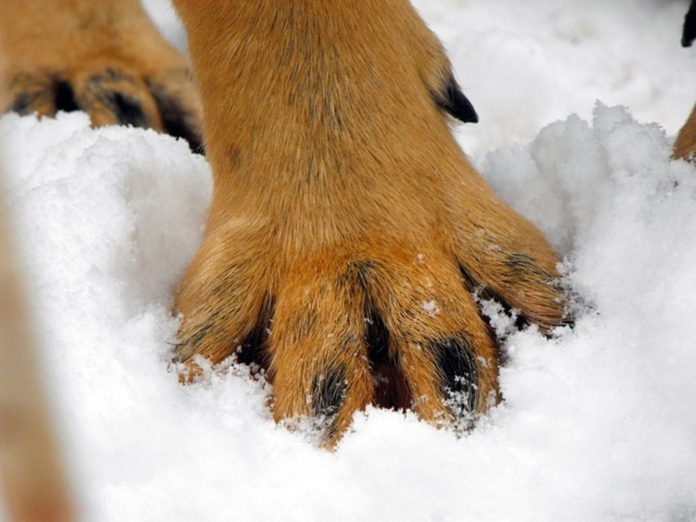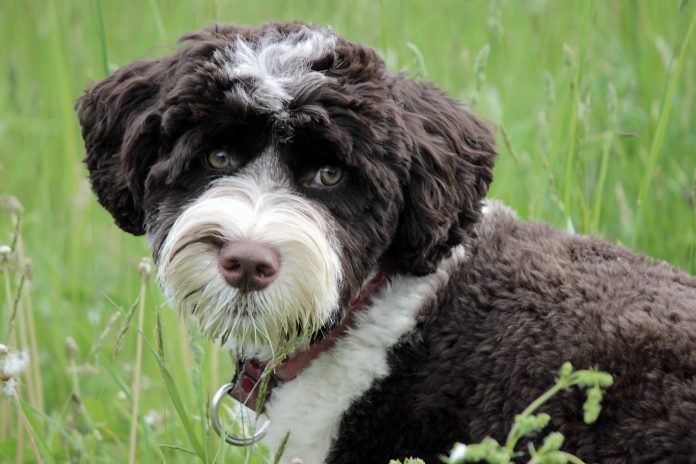When two or more toes fuse together, this condition is called syndactyly or what is more commonly known as webbed feet. This join that occurs between the toes presents an increased risk in our canine friends. The truth is that dogs with webbed feet are prone to developing instability of their joints, which in turn can trigger arthritis.
In fact, if you notice that your dog limps after you’ve exercised him, it wouldn’t hurt to take a look at his paws. Limping can be caused by his webbed feet since during exercise his toes will tend to spread, which will cause the webbing between his toes to stretch.
That being said, in this article, we’ll deal with some basic information about syndactyly, as well as talk about the most common dog breeds with webbed feet.
What Do We Know About Webbed Feet?

Syndactyly, or webbed feet, means that the toes fuse together, either by way of bone or soft tissues which are involved in different ways. As such, this condition can be regarded as simple if the toes are united only by skin and fibrous tissue, and complex if the union entails the bones being linked together as well.
Webbed feet can also be classified as complete when the toes are fully connected, or incomplete when we’re talking about a partial joining together. In addition to this, if syndactyly is associated with other anomalies, we’re dealing with a complicated form of this affection, while if it’s not, we’re dealing with uncomplicated webbed feet.
If we’re talking about dogs, many owners might notice their four-legged friends have webbed feet, but the scientific research regarding this medical issue entails that this is a pretty uncommon condition, which is not yet fully understood. The genetic predisposition has been proved without doubt only in one canine breed, the Australian Shepherd, along with other bone defects: cleft palate, polydactyly, shortened tibia-fibula, brachygnathism, and lethal scoliosis.
In fact, more recent studies suggest that numerical and structural chromosome aberrations may not be involved in all cases of webbed feet, particularly in complete syndactyly. In other words, if your dog has webbed feet it might not be caused by his genetic inheritance at all. However, these findings are counterintuitive, especially since some dog breeds have webbed feet and many practitioners believe these are a result of a genetic mutation a dog gets from the parents.
Are Webbed Feet Dangerous?
There is no simple answer to this question, but yes, webbed feet is a condition that has been known to at least associate with – if not trigger – other health problems. Since dogs use their toes for walking, the webbing between them can cause limping and other affections. We’ll discuss some of them below.
1. Cleft Palate

Apparently, there is a chromosomal mutation that can determine both the emergence of webbed feet in dogs, as well as a cleft palate. That means that the same genetic abnormality that produces unions where there shouldn’t be any, like between the toes, fails to unite the things that should stick together – like your dog’s mouth roof. Ironically, the two sides of his mouth roof couldn’t fuse together when your dog was just an embryo, but instead, his toes did.
The problem with cleft palate is that it leaves an unnatural opening between the nasal passages and the mouth, which can prove quite dangerous since your puppy is prone to pneumonia and other respiratory deficiencies.
2. Shortened Tibia-fibula
The tibia and the fibula are the two bones of the lower rear leg of a dog. The shortened tibia-fibula condition is associated with premature closure of the associated growth plate. It is possible that the same gene that makes the webbed toes appear is responsible for the faster joining of the two bones.
This affection is also quite dangerous because it can lead to bone fractures and limping. As such, it has to be corrected early through surgery.
3. Scoliosis

Scoliosis means the dog’s spine isn’t in a straight line, but it bends to a side. You can ascertain this by touching it and also by looking at how the dog carries his weight, since scoliosis may be accompanied by some visible limping of his back legs. If this condition is left untreated, it can end up partially paralyzing your dog, who will have a very hard time walking.
Additionally, if your dog has scoliosis, he may have a stronger side which is opposed to spinal bending. If he has some weird reflexes in his back legs and increased sensitivity in his back area, which is a valid sign of pain, as well as incontinence, you should know that these are further signs of scoliosis.
Since both webbed feet and scoliosis entail spinal and bone malformations, their linking doesn’t appear serendipitous. What’s more, if your dog can’t walk right because of his syndactyly, there’s no wonder that can lead to scoliosis.
What’s the Treatment?
Webbed feet doesn’t necessarily have to be a dangerous condition. If your dog can’t walk because of his syndactyly, then surgery is a good option for you to consider.
Otherwise, it’s a game of chance: his webbed feet may or may not trigger spinal injuries or bone fractures. If it doesn’t, then great! No need for you to consider preventive surgery, because dogs don’t fare very well after this type of operation, and the recovery time is pretty long. On the other hand, if his webbed feet make him develop bone problems, it’s better to focus on the affected bones, because removing his webbing can’t cure what he has.
The best advice would be for you to talk to your vet about all the options you have and keep an watchful eye over your dog, to prevent further complications.
What Are the Dog Breeds Which Present Syndactyly?

Some dog breeds have webbed feet, a few of them due to genetics, and others because they were specially bred like this. In fact, syndactyly isn’t only noticed in purebloods but also in mixed breeds or even in mutts. However, this condition can normally be seen with dogs who work in water, because they need to swim better and thus they develop an evolutionary paddle-looking join between their toes.
So, without much further ado, below are the top 5 dog breeds with syndactyly.
1. The Newfoundland

This dog was specially bred for Newfoundland fishermen, hence the name. As you know, that particular area in Canada has very cold waters and that’s why this dog had to be bred like he is now.
In fact, he’s so good at swimming and helping people that the 1804 Corps of Discovery Expedition made by Lewis and Clark to cross the Pacific Coast, also had a Newfoundland named Scannon aboard.
He was brought along for many of the same reasons why today’s Newfoundland dogs work with people as assistant lifeguards.
Their very thick fur is at the same time water resistant so they don’t feel nor wetness, nor cold. Their body is pretty muscular, which allows them to do considerable amounts of effort, including pulling the fishermen’s nets. Their enormous size can be likewise useful when saving a drowning victim since Newfoundland can easily support the weight of a grown man. Their unconditional loyalty is yet another one of the traits which make these dogs risk their lives in the search of casualties.
But above all, Newfoundland is also blessed with webbed feet, thick paws, and very long toes. All these features help him swim nimbly and uniquely, since he doesn’t swim like every other dog by paddling the water, but by using the breaststroke motion that even allows him to surf the water, not just plummet through it.
2. The Dachshund

The Dachshund is a small breed of hound which can hunt by smell, which makes him a scenthound. He has really short legs, but an elongated body which renders him perfect for his original purpose. As such, Dachshunds were employed in the 17th century in Germany for their hunting and retrieving abilities. They were supposed to enter the burrows dug by small animals, like badgers. Even now, apart from being one of the most beloved family dogs, they can still assist with hunting and working as military or service animals.
As a piece of trivia, the name Dachshund is of Germanic origin itself, meaning “badger hound”. That was the prey they hunted the most, but they also had to deal with other critters that dig holes and had long tunnels in the ground, such as foxes and rabbits. In fact, there are three sizes of Dachshund: the bigger one, reaching about 30 to 35 pounds, was used for hunting badgers and boars, and the medium one, ranging between 16-22 pounds, had to hunt rabbits, foxes, and badgers, while the small ones of less than 11 pounds are just an indoor human companion.
Their characteristics are what make them good at this type of job. Except for their incredible sense of smell, the shape of their body is long and thin allows them to enter the narrow burrows of small animals. At the same time, their lower body remains quite near the entrance, which means they can pull both themselves and the prey back out.
Apart from this, they have webbed feet which are perfect for turning their paws into a small paddle used for digging fast and throwing the dirt away.
Moreover, the Dachshund is also an agile dog that moves easily and has a lot of strength. He’s pretty courageous, so much so that he’s ready to tackle even animals that are much larger than he is, like boars, which often puts him in dangerous situations. As a plus, he’s very curious and always ready for a new adventure – and that’s why his favorite pastime implies some forms of digging and chasing.
3. The Portuguese Water Dog

This very cute dog breed has ancestors that go back a long time, as far back as the 8th century BC. They were very skilled herding dogs used throughout the plains of central Asia and near the Chinese–Russian border. One theory suggests that in the 5th century AD, the Visigoths brought them along to Portugal, but other scientists argue that they were introduced 3 centuries later, by the Berbers and the Moors. Whatever the truth may be, the Portuguese Water Dog has a rich history of being a savvy working dog.
As such, after reaching Portugal, these dogs were employed as valuable assistants to fishermen who needed the fish to be agilely gathered into their nets. The Water Dogs were also used as messengers between boats and they did a pretty good job of finding lost equipment. Their physical characteristics and personality traits recommended them for a number of other tasks, like fishing in Icelandic waters along with various trawler crews.
By-the-by, the physical characteristics that make the Portuguese Water Dog such a good swimmer include his webbed feet which help him paddle the water faster and more gracefully, as well as aiding his endurance and stamina. Apart from this, the Water Dog’s body isn’t as big as the Newfoundland’s but it’s also pretty muscular, which means he can stay in the water and swim for a prolonged time.
At the beginning of the 20th century though, the modernization of the fishing industry meant that the Water Dogs were soon replaced with more proficient equipment and the breed wasn’t used along the coast of Portugal anymore. However, because these dogs are loyal, friendly, and playful they make top-notch companions for people who like swimming and all sorts of adventures.
4. The German Wirehaired Pointer

This excellent hunter traces his origins back to Germany, as a renowned assistant in bird shooting games. That’s where he began proving his abilities to track down the shot birds and retrieving them to their rightful owners.
The German Wirehaired Pointer has many other breeds in his lineage, including the German Pudel, the German Shorthaired Pointer, the Stichelhaar, the Griffon, and the Polish Water Dog. Perhaps that best explains his hunting skills, his amazing scent, and intelligence, as well as some physical traits which render him perfect for a plethora of sports and hunting activities.
As such, this dog has a waterproof and weather-proof coat, as well as a strong, long body, which means he can hunt whenever and wherever including in the water. His webbed feet are likewise a huge help with retrieving waterfowl prey shot above the water. Using his paddle-like paws and his great smell, the Wirehaired Pointer can jump right into the water, fetch the prey and bring it back to the humans.
Having such a strong constitution means that he can jump in and out of the water as many times as needed, having not only the ability but also the eagerness to spend all of his time hunting and playing fetch. Not to mention that his obedient, calm nature recommends him further for this type of menial job, out of which a Wirehaired Pointer can get a lot of satisfaction.
5. The Redbone Coonhound

In the 18th century, immigrants from Scotia in the US brought along with them red foxhounds, which are one of the ancestors of the Redbone Coonhound. In order to develop a more proficient breed at running fast, hunting and getting a quick scent of the prey, the Georgian hunter George Birdsong developed the early Redbone Dogs. These dogs were crossed with the Red Foxhounds until the breeders were satisfied with the end result. Thus, the Redbone Coonhound was born – an agile and skilled hunting dog.
Since the European hunting dogs weren’t appropriate for the swampy, forestry terrain in the American South which allowed the prey to find shelter in trees instead of digging escape tunnels, the Redbone Coonhounds were especially bred to work in these conditions. They were also chosen from the most courageous dogs that managed to scare even the biggest, most ferocious animals like alligators and bears away from the trees where the raccoons were hiding.
In fact, the Redbone Coonhound doesn’t tire easily at all and can hunt his prey through all sorts of terrains, ranging from rocky hills to swamplands and lakes. He’s particularly well-endowed for making his prey take refuge in trees, as he can run after them for long stretches of time and pick up their smell even after the trail has long gone cold.
Apart from this, the Redbone Coonhound swims incredibly fast and he’s very tenacious and eager to please, that’s why he’ll go anywhere after his prey. Not to mention that he has webbed feet which enable him to cross any swamp or muddy terrain that may come in his way.
All that being said, you can see how all these dog breeds are fierce hunters, devoted friends, and consummate workers. Even though they have webbed feet, they use their natural gifts which help them swim and dig restlessly. However, all these breeds are also prone to hip dysplasia – could that be an unfortunate coincidence, or is it the price they have to pay for their gift?




